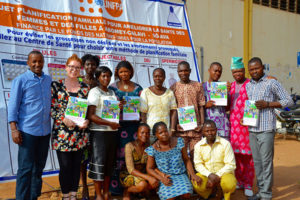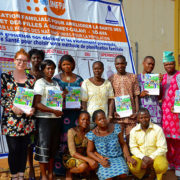Creating a Healthier Future for Urban Adolescents SBCC in Benin: Putting HC3’s French Urban Adolesecent SRH SBCC I-Kit to Use
Months ago, the organization I work with here in Benin, Organization for Service and Life (Organisation pour la Service et la Vie – OSV Jordan), was selected to pilot the Health Communication Capacity Collaborative (HC3) Project’s new Urban Adolescent Sexual and Reproductive Health (SRH) and Social and Behavior Change Communication (SBCC) Implementation Kit (I-Kit). For over 10 years, OSV Jordan has worked in the field of SBCC promoting sexual and reproductive health, with a focus on the most vulnerable populations, including adolescents and youth.
Given that the nine French-speaking countries of West Africa have the lowest modern contraceptive use and the highest fertility rate in the world, SBCC is both challenging and crucial to the continued development of the region. Luckily, the team at OSV Jordan is well-educated and motivated, and is always on the hunt for innovation within the field of SRH.

Kelli Schmitz, second from left, and OSV-Jordan staff hold copies of the HC3 Urban Adolescent SRH SBCC I-Kit during HC3’s recent technical assistance visit to the NGO. HC3 staff Mohamad Sy-Ar pictured at left.
When I first heard of the I-Kit, my first thought was “this is the innovation we are looking for!” and my second was of concern. I was fresh out of my Master of Public Health program, and could not fathom SBCC theories and their application being taught effectively through a manual. Admittedly, I was also intimidated by working with a topic I knew well but in a language – French – I’d only just learned.
Fast forward four months and I am a full believer in the I-Kit. Because of the pre-testing and revisions, the manual –in particular, the example of the fictional town of Zanbe that was used throughout – were culturally relatable for the team. Additionally, the graphics used to explain the SBCC theories simplified a complicated concept into a useable format. Both of these unique features allowed for SBCC concepts to be easily applied to our current target group of adolescents in the urban zones of Azove and Abomey-Calavi.
The I-Kit also allowed OSV Jordan valuable time to analyze and develop an in-depth profile of their target group, teasing out important differences between being an urban adolescent in Azove vs Abomey-Calavi. In the fast pace world of implementation in global health, this was a rare opportunity to slow down and focus more on program design rather than implementation. While working on Essential Element #6 (Identifying Communication Channels in the Urban Environment), we realized that our current communication channels of in-person activities and radio messages did not line up with the communication channels available to our target group.
As a direct result of OSV Jordan’s work with the I-Kit, the organization’s mission statement was changed to include adolescents and the problems they face, such as early pregnancy. Additionally, OSV Jordan and their funder, UNFPA, are now in talks to implement a new communication strategy involving SMS messaging and social media this summer with adolescents in the Adjohoun-Bonou-Dangbo health zone. SBCC now plays a permanent role in all of our talks of future program design, allowing a relatively small NGO to make an impact on the sexual and reproductive health of adolescents.
To use the I-Kit yourself, visit: [English] [French]
Let others know you’re using the I-Kit on Springboard for Health Communication, an online network for social and behavior change communication professionals.
* The opinions expressed here are my own and do not represent those of the U.S. Government or the Peace Corps.








Leave a Reply
Want to join the discussion?Feel free to contribute!